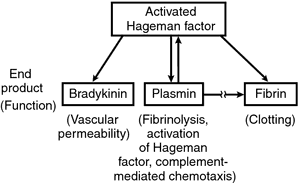DEFINITION
Coagulation factor XII, also known as Hageman factor, is a plasma protein. It is the zymogen form of factor XIIa, an enzyme (EC 3.4.21.38) of the serine protease (or serine endopeptidase) class. In humans, factor XII is encoded by the F12 gene.

THE GENE
Wikigenes includes links to
- NCBI Gene
- NCBI SNP
- iHOP resource
- OMIM
- SNPedia
- UniProt
- Ensembl
- HGNC
CHEMICAL STRUCTURE AND IMAGES
When relevant for the function
- Primary structure
- Secondary structure
- Tertiary structure
- Quaternary structure
Protein Aminoacids Percentage
The Protein Aminoacids Percentage gives useful information on the local environment and the metabolic status of the cell (starvation, lack of essential AA, hypoxia)
Protein Aminoacids Percentage (Width 700 px)

SYNTHESIS AND TURNOVER
mRNA synthesis
protein synthesis
post-translational modifications
degradation
CELLULAR FUNCTIONS
cellular localization,
biological function

 Bradykinin Schizophrenia
Bradykinin Schizophrenia
REGULATION
DIAGNOSTIC USE
Versatility of the complement system in neuroinflammation, neurodegeneration and brain homeostasis, 2014
While complement activation and its interaction withmicroglial cells appear necessary for brain wiring during the postnatal period, recent evidence indicate that when this developmental program becomes aberrant in the immature brain or is recapitulated during adulthood molecular cascades related to neurodegenerative processes may be initiated (Stephan et al.2012). For example, during the postnatal period, the inappropriate activation of the complement cascade causes profound synapse elimination that leads to neuropsychiatric diseases , such as autism or schizophrenia (Maternal infection and immune involvement in autism, 2011).